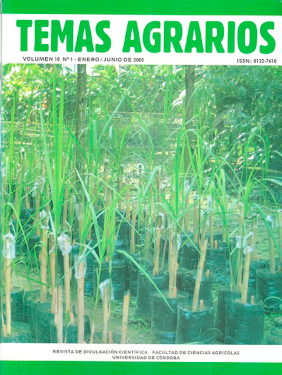Effect of two cultivation systems on transgenic cotton (Gossypium hirsutum L.) genotypes in the mid Sinu valley
Efecto de dos sistemas de labranzas en genotipos transgénicos de algodón (Gossypium hirsutum L.) En el Valle del Sinú

This work is licensed under a Creative Commons Attribution-NonCommercial 4.0 International License.
Show authors biography
To contribute to the design of a plan of handling for transgenic genotypes, agreed with the environmental conditions of the Sinú valley, will allow the optimization of the use of this technology. It is of interest to establish a line base of handling information for the transgenic cotton genotypes by means of the evaluation of system of efficient and profitable farming in the use of the varieties RR and Bt. The work was made in the C.I. Turipaná, a design of divided parcels was used (factors: farming and variety), three replicates. The height of the plant was lower in the conventional system farming, the conditions of movement of the ground in direct seedtime did not allow to greater conservation of the stored water and growth in the cotton plants. The height was not affected by the variety. The number of branches, specks, retention of structure by position and sites with abortion of fruits were not affected by the factors analyzed nor its interaction. The varieties Opal Delta and NuOpal were superior in yields to the presented/displayed ones by variety RR. This difference of the yield was possibly due to the effect of the gene incorporated in the variety RR on the physiology of the plant. Direct seedtime presented/displayed favorable conditions such as greater humidity retention so that a greater weight of speck is expressed. Economically the best treatment was direct Sowing of Opal Delta with a rate of marginal return of 18,4%.
Article visits 637 | PDF visits
Downloads
- Altieri, M. 1999. Diez razones por las cuales los OGM no solucionaran nada. http// www.eco-sitio.com.ar/ diez_razones.html
- Cornerhouse. 1999. Biodiversidad sustento y culturas. Falsas promesas de la industria biotecnológica. http// www.grain.org/biodiversidad/?id=71
- CORPOICA. 2004. Costos de producción cosecha de algodón 2003 –2004. Documento en edición.
- García, D. 2004. Biotecnología a raudales, el poder de los transgénicos. http// www.cazurrabit.com/comun/ sumario/
- Joensen, y Mae-wan, 2004. La paradoja de los transgénicos en Argentina. http// www.pampagringa.com.ar/ agropecuaria/soja/soja-trans.html
- Martínez, 2004. Efecto de tres sistemas de labranza sobre algunas propiedades físicas en un endoaquet, el desarrollo de las raíces y rendimientos de maíz y algodón en le valle del Sinú. Tesis M.Sc. Universidad Nacional de Colombia. Palmira.
- Rankin, M. 1998.Crops and Soils Agent - Fond du Lac County. University of Wisconsin – Extension. http// www.uwex.edu/ces/crops/ RRsoybn.html




















